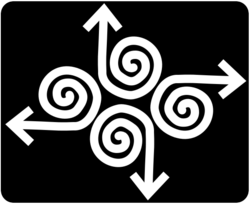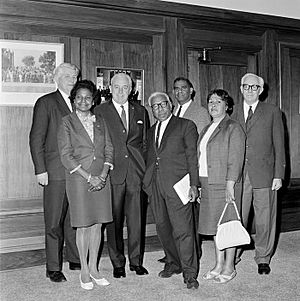Federal Council for the Advancement of Aborigines and Torres Strait Islanders facts for kids

Logo of the FCAATSI
|
|
| Abbreviation | FCAATSI |
|---|---|
| Formation | 16 February 1958 |
| Founded at | Adelaide, South Australia, Australia |
| Dissolved | 1978 |
| Focus | Indigenous Rights Activism |
| Headquarters | Adelaide, South Australia (1958–?) Melbourne, Victoria (pre-1967) Sydney, New South Wales (post-1967) |
|
Formerly called
|
Federal Council for Aboriginal Advancement (FCAA) |
The Federal Council for the Advancement of Aborigines and Torres Strait Islanders (FCAATSI) was a major civil rights group in Australia. It started in Adelaide, South Australia, on 16 February 1958. Back then, it was called the Federal Council for Aboriginal Advancement (FCAA).
FCAATSI was the first national group to speak up for the rights of Aboriginal Australians and Torres Strait Islanders. It played a big role in getting the 1967 Referendum passed. This referendum changed the Australian Constitution to better support Indigenous people. In the 1970s, the group changed its name to the National Aboriginal and Islander Liberation Movement (NAILM) before it closed down in 1978.
Contents
Why FCAATSI Was Formed
People had wanted to unite groups fighting for Aboriginal rights for a long time. Two main events in the mid-1950s made this idea stronger.
First, a group in London called the Anti-Slavery and Aborigines' Protection Society planned to talk to the United Nations about Aboriginal people in Australia. Lady Jessie Street visited Australia to gather information for this.
Second, there was a lot of concern about the living conditions of Aboriginal people in the Warburton Ranges. A report and a film called Manslaughter showed how tough life was for them. This caused public outrage and led many people, both Indigenous and non-Indigenous, to demand change.
These events inspired activist Shirley Andrews to start planning a meeting in 1957.
FCAATSI's History
Starting the Council (1958)
From 14 to 16 February 1958, a special meeting took place in Adelaide. Twelve people from nine Aboriginal rights groups attended, along with twelve observers. This meeting led to the creation of the Federal Council for Aboriginal Advancement (FCAA).
The main goal was to bring together different groups that were already working for Indigenous rights. They wanted to help Aboriginal people become "self-reliant, self-supporting members of the community." This was the first time a national group represented Aboriginal interests. Charles Duguid, a long-time campaigner for Aboriginal rights, became the first president.
The council set five main goals:
- Equal citizenship rights for Indigenous Australians.
- A good standard of living, just like other Australians.
- Equal pay for equal work and fair job protection.
- Free and required education for Aboriginal people who had joined mainstream society.
- Keeping all remaining native reserves for Indigenous ownership.
Bringing these different groups together was a big step forward. It helped change public opinion so that more people believed Aboriginal people deserved equal rights.
Growing Stronger (1958–1966)
The FCAA quickly grew. New groups joined, like the Aborigines and Torres Strait Islanders Advancement League in Cairns (1960) and the Northern Territory Council for Aboriginal Rights (1961). The Northern Territory group was special because 75% of its leaders had to be of Aboriginal descent.
The number of members grew a lot. In 1958, there were 25 founding members, with only 4 being Aboriginal. By 1965, there were 220 members, and 65 of them were Aboriginal. From 1963, FCAATSI held yearly conferences in Canberra. By 1970, about one-third of the people at these conferences were Indigenous.
In 1964, the group decided to include Torres Strait Islanders in its work. So, its name changed to the "Federal Council for the Advancement of Aborigines and Torres Strait Islanders."
Joe McGinness became the first Aboriginal president of FCAATSI. Stan Davey was the secretary.
The 1967 Referendum
FCAATSI played a huge part in the 1967 Referendum. In 1962, they started a national campaign to get the Australian government more involved in Aboriginal affairs. They collected over 100,000 signatures on a petition.

After much effort, FCAATSI members met with Prime Minister Robert Menzies in 1965. This meeting was very important. It helped change the government's mind, leading to the successful 1967 Referendum. This referendum gave the Australian Parliament the power to make laws for Aboriginal people across the country.
Debate Over Indigenous Leadership (1967-1970)
The success of the 1967 Referendum was a big win, but it also caused some disagreements within FCAATSI. Some people felt that the group's leaders were mostly white, not Indigenous. This led to some important Indigenous leaders, like Oodgeroo Noonuccal and Charles Perkins, leaving the group. Faith Bandler then became the acting General Secretary.
Many Indigenous members felt it was time for Aboriginal people to lead the fight for their own rights. They believed the focus should be purely on Indigenous issues. A report in 1968 by Barrie Pittock said that Aboriginal people needed to be the spokespeople for their own communities.
National Tribal Council
This disagreement led to a split at the 1970 Annual Conference. Some members wanted to limit voting rights and membership only to Indigenous people. When these ideas were not accepted, they left FCAATSI.
These members, including Kath Walker (later known as Oodgeroo Noonuccal) and Douglas Nicholls, formed a new group called the National Tribal Council. This new council allowed only Aboriginal or Islander people to be full members. Kath Walker became its national chair. Other important members included Denis Walker, John Newfong, Chicka Dixon, Gary Foley, Naomi Mayers, and Bruce McGuinness. The National Tribal Council lasted for about three years before it disbanded.
Decline and End (1970-1978)
By 1973, the idea of an Indigenous-led council finally came true. However, many new groups were also fighting for Indigenous rights. The government also created its own departments, like the Department of Aboriginal Affairs, to work on Indigenous issues. This meant FCAATSI became less important.
FCAATSI changed its name one last time to the National Aboriginal and Islander Liberation Movement (NAILM). But when the government stopped funding the group in 1978, it had to close down.
Notable members
See also

